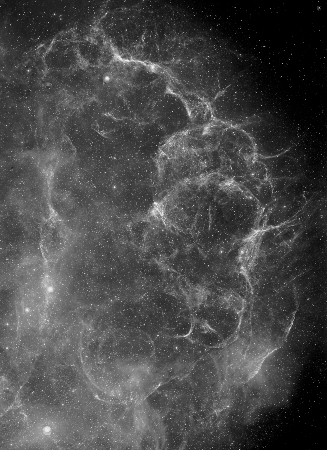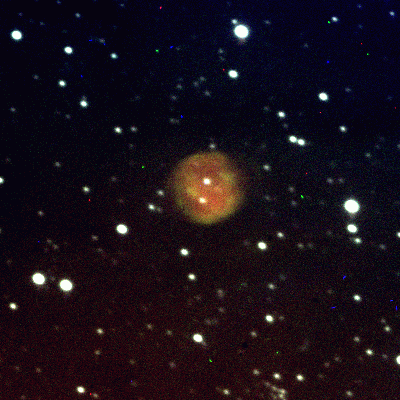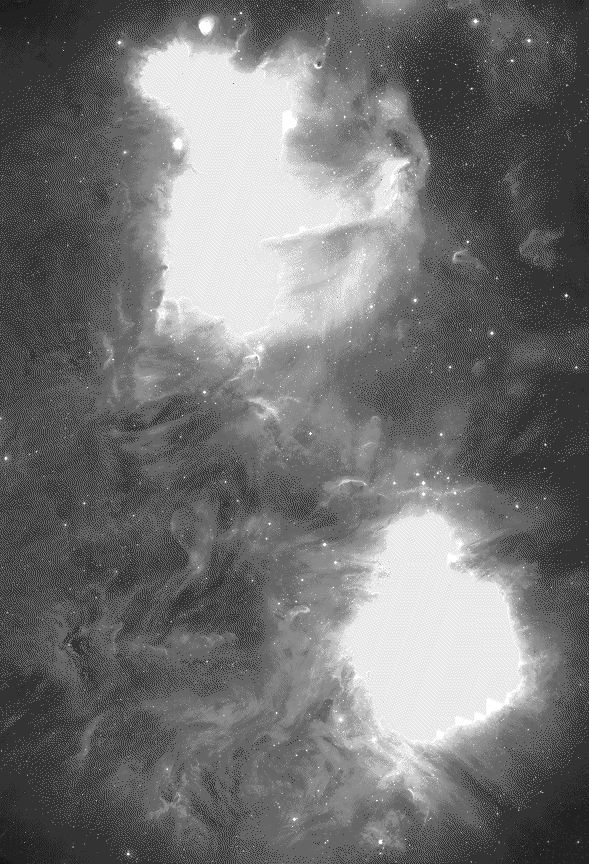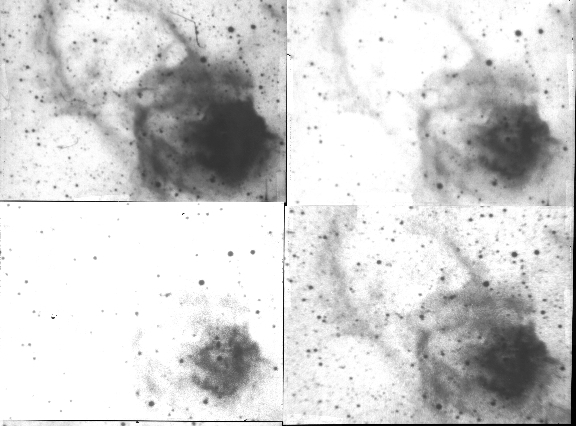

[ROE home page] [WFAU] [IfA] [ATC] [UKST home page] [AAO home page] [AAO H-alpha page] [Search]
![]()



![]()
 Summary
Summary 
 AAO/UKST H-alpha Survey community questionnaire: RESULTS summary
AAO/UKST H-alpha Survey community questionnaire: RESULTS summary  The need for the survey
The need for the survey  Survey Details
Survey Details 
 Map of AAO/UKST H-alpha survey area
Map of AAO/UKST H-alpha survey area  The H-alpha filter and detector
The H-alpha filter and detector  Survey planning and logistics & tie-ins with other
surveys
Survey planning and logistics & tie-ins with other
surveys  The roles of the AAO and WFAU
The roles of the AAO and WFAU  Survey Availability and requests for
new material
Survey Availability and requests for
new material  Preliminary H-alpha image comparisons
Preliminary H-alpha image comparisons  The H-alpha Survey Consortium
The H-alpha Survey Consortium 
 Survey discoveries and a selection of
current projects and papers
Survey discoveries and a selection of
current projects and papers  AAO/UKST H-alpha International Workshop, Sydney (held April 16-18th 1997)
AAO/UKST H-alpha International Workshop, Sydney (held April 16-18th 1997)
 Powerpoint presentation on H-alpha survey given at the Preston `New Era of Wide
Field Astronomy' Meeting, August 2000
Powerpoint presentation on H-alpha survey given at the Preston `New Era of Wide
Field Astronomy' Meeting, August 2000 ![]()
![]()
H-alpha emission lines from HII regions are one of the most direct optical tracers of current star formation activity. These lines also trace out the distribution of ionized gas in the ISM in general revealing for example: stellar outflows in regions masked by strong reflection nebulae; shocks from high velocity galactic HI clouds; the optical couterparts of supernova remnants; stellar wind-blown bubbles, shells, sheets and filaments and emission nebulosity close to young stellar sources. The spatial extent and detailed morphology of HII regions, OB associations and the wide variety of structures (shells, rings, holes, bubbles, filaments and arcs) over a range of scales from a few arcseconds to tens of degrees can be particularly well studied by H-alpha imaging.
The only previous UKST H-alpha survey work dated from the late 1970's (Davis, Elliot & Meaburn, 1976) which used mainly coarse grained (though fast) 098 emulsion and a far from optimum filter. Many parts of the Galactic plane were unsurveyed at decent resolutions, particularly the outer extensions beyond a few degrees from the Galactic equator, whilst the Northern Milky-Way above Dec -20degrees has not been covered at all. Progress in other wavebands highlighted the paucity of the optical counterpart for the detailed study of Galactic gas.
CCDs cannot yet provide the combination of wide-area coverage, uniformity and high resolution required. The new AAO/UKST H-alpha survey fills this gap by combining an exceptional quality H-alpha narrow-band filter in combination with fine grained Tech-Pan films as detector.
Our new survey will clearly contribute much to the detailed investigation of star formation and the general ISM in terms of its coverage and resolution.
![]()
![]()
The survey is being undertaken with a specially commissioned narrow-band interference filter together with fine grained Tech-Pan film-based emulsion as the detector. CCDs cannot yet match the wide-area coverage, uniformity and resolution of the UKST/Tech Pan combination for undertaking a Galactic Plane H-alpha survey.
BARR Associates provided an interference filter of exceptional specification and quality that covers a substantial fraction of the UKST's large field. The choice of central wavelength (6590 Angstroms) and bandpass (70 Angstroms) work effectively in the UKST's fast f/2.48 converging beam. The 305mm diameter filter is coated on a 356 x 56 mm RG610 (red) substrate giving a 5.5 deg diameter field. Peak filter transmission is >85%.
The CSIRO National Measurement Laboratory in Sydney, Australia have independently confirmed that the filter meets the stringent optical specifications set. The superb optical quality of the filter was demonstrated on the telescope during survey commissioning during April 1997. H-alpha exposures taken in good seeing exhibit excellent imaging and uniformity across the entire field and confirmed the clear (circular) aperture of excellent H-alpha sensitivity of close to 305 mm, or a little over five degrees on the sky.
Figure.1a-b gives 5x6 arcminute areas taken from one of the first 2 hour H-alpha test exposures.
Figure.2 gives the IIIaF and Tech-Pan emulsion sensitivities as a function of wavelength which demonstrates that there was no speed, sensitivity or reciprocity penalty in adopting Tech-Pan for use with a narrow-band H-alpha filter c.f. IIIaF.
Tech-Pan's superiority can also be seen in Figure.3a-d which shows various comparisons between results from the new filter/emulsion combination and past UKST exposures taken with other filters and emulsions of the same area of sky.
 Resolve out point sources from more extended emission
Resolve out point sources from more extended emission
 Enable detection of more distant planetary nebulae in the Magellanic clouds.
Enable detection of more distant planetary nebulae in the Magellanic clouds.
 Determine accurately surface brightness and its variations in extended
regions.
Determine accurately surface brightness and its variations in extended
regions.
 Provide better definition of the sharp shock fronts seen around ionized
gas clouds.
Provide better definition of the sharp shock fronts seen around ionized
gas clouds.
 Investigate in more detail the morphology and environment of Herbig-Haro
objects and find more distant or less extended examples.
Investigate in more detail the morphology and environment of Herbig-Haro
objects and find more distant or less extended examples.
![]()
Given the filter's 5.5 degree circular field, normal UKST 5 degree field centres could not provide full contiguous H-alpha sky coverage due to the 1.5degree overlap between the 6.5x6.5 sized fields. A small 1degree area in the overlap regions was missed. We have thus adopted a conservative 4 degree field centre separation which ensures no gaps in H-alpha coverage. Consequently 233 such fields are needed to cover the Southern Galactic Plane. This may later be extended to the outer regions of the Galactic Plane and to declinations from +0 to +15 degrees. Exposures are of the order of 3 hours and the initial survey region will take about 3 years to complete. Although not sky-limited, the 3 hour exposure times are a good compromise between survey progress and exposure quality due to the increased likelihood of seeing variations, cloud interruptions and effects of field rotation.
The narrow-band nature of the H-alpha filter means that the survey could continue in good seeing grey/bright time when the sky is too bright for normal observations.
The photometric integrity of the survey is currently being assessed via independent narrow band CCD photometry from the Curtis Schmidt at CTIO and with reference to previously studied objects over a range of UKST fields.
The prospects for collaboration and comparison from studies in other wavebands are excellent. Any interested groups or individuals are encouraged to contact the H-alpha survey consortium or the Wide Field Astronomy Unit at ukstu@roe.ac.uk for further information.
![]()
Given the location of SuperCOSMOS within the new WFAU and the presence of key personnel the WFAU/IfA will play a crucial role in ensuring proper exploitation and dissemination of the survey data products. The WFAU will be closely involved in survey scanning strategy, on-line digital atlas construction, data quality control, archival of both film and pixel data and crucially community access to the H-alpha survey data products via a suitable www interface. Full survey Quality Control is also being carried out on the survey material when it arrives back at the WFAU.
Apart from providing the filter the AAO has prime responsibility for undertaking the survey on the UKST and to provide basic support for the survey as well as the day to day operational tasks such as processing, initial quality control and shipment of the film material to the WFAU for archival and SuperCOSMOS scanning.
![]()
Rigorous quality control of the survey is being undertaken to ensure that as far as possible a survey of uniform quality and depth is obtained.
It is intended that the WFAU will produce a digitised survey map of 10micron resolution pixel data which will be released to the astronomical community via a suitable www interface. Unlike previous UKST surveys film copies of the survey material are unlikely to be available.
General contact details for queries etc are:
UK applicants Mike Read Tel: 0131 668 8328 Wide Field Astronmy Unit, fax: 0131 662 1668 Institute for Astronomy, email:ukstu@roe.ac.uk Royal Observatory Blackford Hill, Edinburgh EH9 3HJ
or
Australian applicants Paul Cass Tel: 061 68 42 6316/6291 AAO fax: 061 68 84 2298 Coonabarabran email: cpc@aaocbn.aao.gov.au NSW 2357 Australia
Other nationalities can apply to either panel.
![]()

![]()
 To promote the H-alpha survey to the
community via the www, articles, an
international workshop and
scientific papers
To promote the H-alpha survey to the
community via the www, articles, an
international workshop and
scientific papers
 To, where necessary, provide feedback
and advice to the AAT Board, AAO and WFAU management and the Wide Field
Astronomy Panel (WFAP) on the scientific strategy, dividends and
opportunities offered by the survey
To, where necessary, provide feedback
and advice to the AAT Board, AAO and WFAU management and the Wide Field
Astronomy Panel (WFAP) on the scientific strategy, dividends and
opportunities offered by the survey
 To undertake scientific evaluation
and exploitation of the survey material including obtaining CCD calibration
data for every survey field
To undertake scientific evaluation
and exploitation of the survey material including obtaining CCD calibration
data for every survey field
 To provide via the co-PI's the
overall scientific leadership of the survey
To provide via the co-PI's the
overall scientific leadership of the survey
Prof.W.J.Zealey, + Stacy Mader & Andrew Walker, (University of Wollongong)
Dr.A.Green & Dr Vince McIntyre (Univ.Sydney),
Mr.M.Hartley, Dr.J.Bland-Hawthorn, Dr.D.Malin, Dr.R.D.Cannon (AAO)
Dr.M.Fillipovic, Dr.G.White + students (Univ.Western Sydney)
Dr.M.Mashedar, Robin Walker & John Precious (Univ.Bristol), Dr.M.G.Edmunds (Univ.Cardiff)
Dr.D.Morgan (Royal.Obs.Edinburgh).
![]()
Simple visual scrutiny of the H-alpha survey films reveals stunning detail and imaging which has already resulted in the discovery of many new features and objects. A variety of different projects are underway to exploit the survey resolution, coverage and depth which have already resulted in a range of discoveries and publications. Most results so far are from visual scans of the survey material which bodes well for the provision of digital data which is now becoming available. A selection of some of the most important on-going projects are:
This list above is by no means exhaustive and simply reflects some of the current interests of the consortium and affiliates. The general community is invited to consider their own research projects and are free to contact consortium members for advice, information, collaboration opportunities etc.
![]()
![]()
e-mail: qap@roe.ac.uk
Last revision: 23rd October 2000
![]()